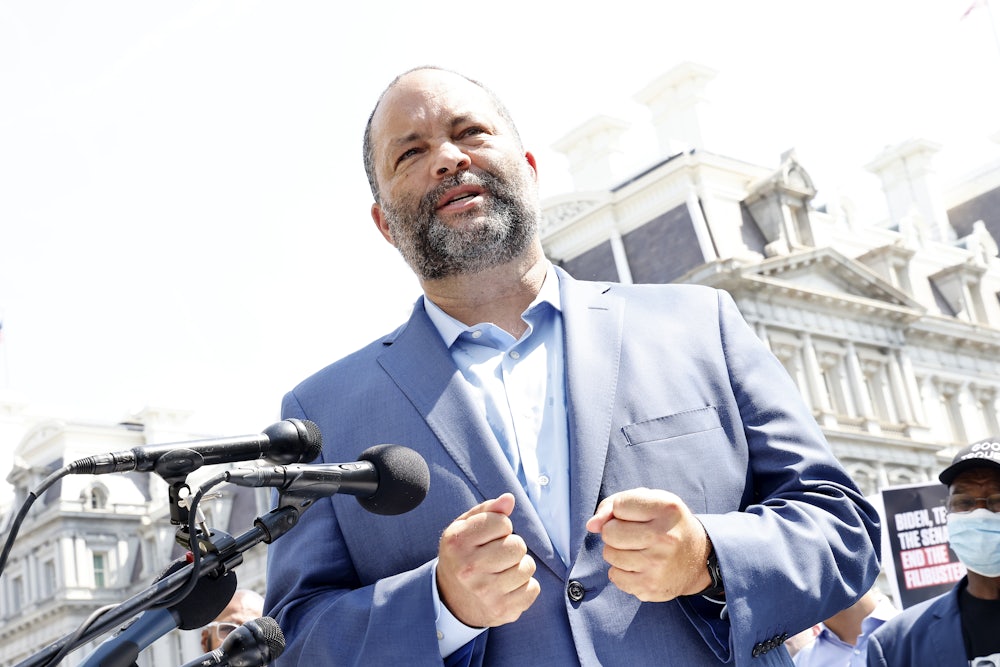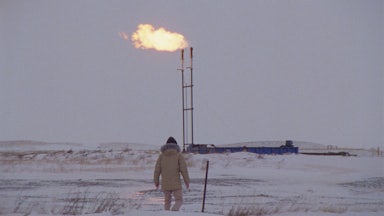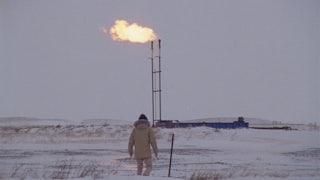On an all-staff video call earlier this month that sounded scripted, attendees said, Sierra Club senior management announced massive layoffs as part of a top-to-bottom restructuring of the 130-year-old environmental organization. Executive director Ben Jealous relayed a personal story about having been fired from an entry-level organizing position at another green group while still fresh out of college, before ultimately going on to “brighter and better” things, as one attendee summarized. A few minutes after the call ended, E&E News ran an article announcing the restructuring, featuring quotes from an interview with Jealous conducted that same day. He’d explained the rationale for layoffs to a reporter, that is, before sharing those details with employees on their receiving end.
The Sierra Club says the layoffs—the precise number yet to be revealed—are meant to help fill a projected $40 million shortfall for the coming year. (For context, the Sierra Club spent $151 million in 2022.) The budget the group’s board of directors approved the day before the call features drastic cuts that would purportedly shrink that deficit to just $2.3 million. The days since the all-staff call have seen a fractious battle between the Club’s top leadership and the Progressive Workers Union, or PWU, which has two bargaining units representing roughly 400 Sierra Club employees (out of a total pre-layoff staff of about 800) around the country. So far the PWU has filed two unfair labor practice charges with the National Labor Relations Board. The first, filed last week, accuses the Club of failing to provide necessary information for bargaining. A second charge filed Tuesday morning alleges that management is violating its collective bargaining agreement and is bargaining in bad faith.
This is a delicate moment for the Sierra Club and the environmental movement more broadly. With an estimated 4,000 volunteers nationwide, the Club divides its work between state and local chapters and national campaigns to do everything from build out renewables to conserve wildlife and take on banks’ fossil fuel financing. Like just about every other green group that has presence in D.C., the Club also spent considerable time over the last two years working to strengthen and pass what became the Inflation Reduction Act, the main prize of which (for climate advocates) is roughly $400 billion of incentives for renewables, electric vehicles, and other clean energy technologies. Though the Club has been relatively tight-lipped about how it’s amassed such a large deficit, its situation isn’t unique among climate-focused nonprofits navigating a post-IRA landscape. What is their role in the far less flashy work of helping implement that bill while continuing to fight battles at the local and state level? And how do you convince donors that those things are important?
Sierra Club communications director Jonathon Berman told me over email that the new structure is a response to both budget constraints and longer-running strategic priorities, noting that the group faced “significant fundraising uncertainty due to overall economic trends.” The Club will be “evolving from a campaigns-based model into a regional model consisting of four distinct regions,” he said. It plans to eventually have a director in all 50 states so as to “better prepare our organization to meet a critical moment in the climate fight” and “fulfill the full potential” of the Inflation Reduction Act. “This means creating new positions, eliminating some old positions and re-imagining others,” Berman wrote.
The union, on the other hand, says that “we didn’t get details about the restructuring plan until they told all the staff on a staff call. It’s still very vague and confusing and there are a lot of questions,” PWU president and Sierra Club employee C.J. Garcia-Linz said over the phone on Tuesday. “We know that the organization was top-heavy and we want to get back to our grassroots. But we also want answers.” (Another union, the Sierra Employee Alliance, has a separate collective bargaining agreement that exclusively covers employees based at the Club’s Bay Area headquarters.)
There seems to be very little in this that PWU and Sierra Club management agree on. Berman called the NLRB charge that Sierra Club has withheld information and is violating the collective bargaining agreement with PWU “baseless,” and said it’s PWU that’s undermining the CBA: “We take the bargaining agreement seriously and are disappointed the Union has chosen to act in a manner inconsistent with the Collective Bargaining Agreement,” he said, adding that management had “engaged in hours of conversations with the union to understand their needs and to be responsive to their requests.” Garcia-Linz disputed Berman’s accusation via email: “We are fully exercising our rights under the CBA and have taken no action contrary to that agreement.”
It’s already been a tumultuous few years for the Sierra Club. Amid uprisings for racial justice in the summer of 2020, the organization grappled with the racist legacy of its founder, John Muir, and the early conservation movement’s embrace of white supremacy. Employees also criticized the organization’s handling of gender-based discrimination and abuse, which came to a head after a volunteer was publicly accused of rape. In 2021, the Club brought in an outside consultant, Ramona Strategies, to conduct an internal review and make recommendations as part of a “restorative accountability process.” The resulting report found a culture that lacked accountability for abuse and misconduct and disproportionately impacted workers from historically marginalized groups. Executive director Michael Brune resigned not long after the report was released last summer.
The Club subsequently created its equity and investigations teams, in accordance with the report’s recommendations. None of those employees were covered by PWU’s collective bargaining agreement, however, and their teams were among the first to be liquidated in the restructuring process. “They were called to a meeting with HR, and then by the time they got back to their desk they were locked out of their account,” Garcia-Linz said. Asked about these layoffs, Berman said that the restorative accountability process “has fallen short of its intended goals. This is unacceptable. Reorganization will include this critical work moving forward.” He said the equity team’s work is now being led by existing staff.
At an all-staff video call after the initial restructuring announcement, where the chat function was disabled, employees held up signs asking upper management to “Live Your Values” and questioning the dismissal of the equity team. Some changed their display names to slogans of solidarity. The next all-staff call on the matter was presented in a webinar format, where attendees can’t speak or see one another and have to submit written questions to call organizers.
“We’re experiencing the same sort of tactics when we try to organize and ask questions that we experience from big utility companies or big polluters,” Garcia-Linz said, likening it to colleagues’ experiences in campaigns targeting Duke Energy, where the power company “made it impossible to have meaningful engagement.”
Whatever the intent, the result, staffers say, has been chaos. Some staff members are now juggling hours of union meetings on top of their regular responsibilities. The status of many of Sierra Club’s ongoing advocacy campaigns has been left in the air as workers are let go. “Sierra Club keeps telling us that the work isn’t going to be affected, but we already have chapter staff who were relying on campaign organizers. They’re no longer there so [the chapters are] just stuck,” Garcia-Linz said.
Senior staff say they were excluded from the secretive restructuring process, as well. Michelle Mascarenhas—a veteran climate justice organizer who joined the Club as its national director of campaigns last February—emailed board members the morning they approved the budget. Over the last two months, she wrote, “I was excluded from meetings and from the information flow needed to do my job. My direct reports were asked to join the new budgeting process and told not to tell me. They were not told upfront that they would be leading the redesign of the campaign structure for the whole organization (which is my job, not theirs). But that is what they have ended up doing.”
Mascarenhas added that, despite repeated requests, it had been more than two months since she had seen a campaign budget, typically delivered weekly during budgeting season so that the end product can reflect the work happening on the campaigns she oversees. “Staff have been extremely concerned, scared, confused, and upset about the lack of transparency. Managers have been unable to guide and support their staff,” she said, noting that “the only real work I have to do is approving timesheets and expense reports while the Campaigns Unit I was hired to direct has been dismantled all around me in rooms I was completely closed out of.”
“As a woman of color put in this position, my leadership has been debased rather than supported by this process,” Mascarenhas continued. “I have been marginalized in a very deliberate way. I have felt anxious and ashamed that I have not been able to support my teams and the movement I came here to help build.”
“Far too often, women, especially women of color, are excluded from critical conversations,” Berman responded by email when asked for comment about Mascarenhas’s allegations. “This is why we took an intentional process, bringing together a diverse group of people from various backgrounds, race, and gender, that included cohorts of leaders from across the organization to ensure we held firm to our values,” he wrote, while balancing constraints and strategic priorities.
The full scope of the restructuring isn’t yet clear. Certain employees have been presented with voluntary layoff packages. While unionized employees’ collective bargaining agreement outlines a process for PWU to help shape those packages, Garcia-Linz says they were given no such opportunity. And whereas a previous round of layoffs two years ago was open to any employee who wanted to take the opportunity to leave, packages now are only being offered to certain staffers. The “layoff list,” as employees have called it, has put entire program areas on the chopping block, including those dealing with labor, international climate issues, and environmental justice. Some employees were told they can apply for newly created roles, leaving them to compete for fewer positions and against new recruits.
Workers who aren’t being laid off have received new job descriptions. A staffer in the organizing department for one of Sierra Club’s national energy campaigns—who spoke anonymously out of fear of retaliation—said they received theirs last Wednesday. That Friday, everyone in the same job category had a meeting where they could ask senior management questions about the changes. “They told us we would have to sign [the description] by the end of May for our new job. If we don’t sign,” the staffer recalled, “then they would count it as a resignation.” The staffer, who has been with the Club for more than five years, said their new job description collapses several roles into one. H.R., though, determined that the description didn’t constitute a substantive change to their work responsibilities, so they aren’t eligible for the minimum 7 percent raise the union contract promises employees who are asked to take on more work. On Wednesday, 92 percent of unionized staff being consolidated into the same new unit sent a letter to Jealous and the Sierra Club board opposing the job description updates as presented, requesting a longer timeline and more information before signing, revisions to the descriptions, and a more collaborative process.
“If we don’t get those job descriptions changed, it’s not a job I want to do because it’s so vague as to leave me open to retaliation from a bad manager,” the staffer told me, adding that there appeared to be little room for negotiation. “A manager who for some reason disliked me could give me a bad performance evaluation because I’m not doing one of the many things in my job description. I don’t want to open myself up to that.”
In its most recent NLRB filing, as in the staffer’s letter sent Wednesday, PWU argues that the terms on which new job descriptions are being presented run afoul of PWU’s collective bargaining agreement. That contract outlines both a specific process by which unionized employees can be dismissed, and that management cannot unilaterally make substantive changes to bargaining unit members’ job duties.
Asked whether management had violated the collective bargaining agreement on these fronts, Berman said, “As we undertake this critical and necessary work for the sustainability of the Sierra Club, it is our hope and desire that the union will be a partner in these efforts.”
Negotiations over the restructuring process and layoffs are ongoing. Several employees fear the restructuring fight signals that the next phase for the Sierra Club will be a less collaborative one overall. “The way it has been communicated to us,” the energy campaigns staffer told me, “is that these decisions have been made: You can complain about it but this is happening and we’re not going to rethink our approach.”










